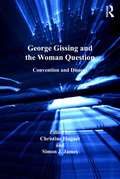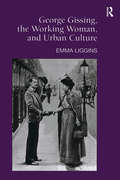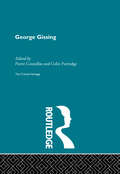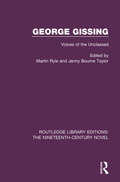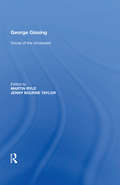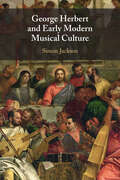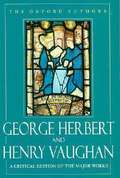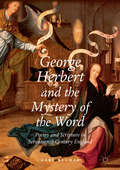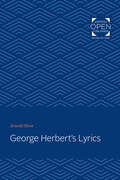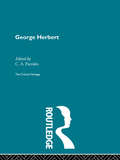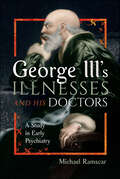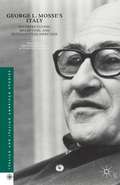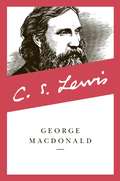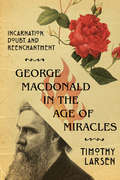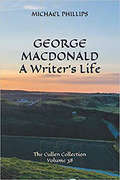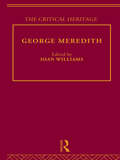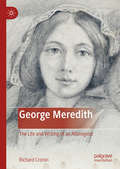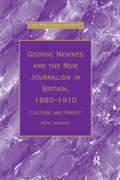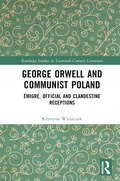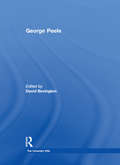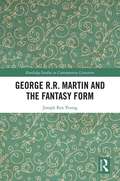- Table View
- List View
George Gissing and the Woman Question: Convention and Dissent (The Nineteenth Century Series)
by Christine HuguetApproaching its subject both contextually and comparatively, George Gissing and the Woman Question reads Gissing's novels, short stories and personal writings as a crux in European fiction's formulations of gender and sexuality. The collection places Gissing alongside nineteenth- and twentieth-century authors as diverse as Paul Bourget, Ella Hepworth Dixon, May Sinclair and Theodore Dreiser, theorizing the ways in which late-Victorian sexual difference is challenged, explored and performed in Gissing's work. In addition to analyzing the major novels, essays make a case for Gissing as a significant short story writer and address Gissing's own life and afterlife in ways that avoid biographical mimetics. The contributors also place Gissing's work in relation to discourses of subjectivity and intersubjectivity, identity, public space, class and labour, especially literary production. Increasingly viewed as a key chronicler of the late Victorian period's various redefinitions of sexual difference, Gissing is here recognized as a sincere, uncompromising chronicler of social change.
George Gissing, the Working Woman, and Urban Culture
by Emma LigginsGeorge Gissing's work reflects his observations of fin-de-siècle London life. Influenced by the French naturalist school, his realist representations of urban culture testify to the significance of the city for the development of new class and gender identities, particularly for women. Liggins's study, which considers standard texts such as The Odd Women, New Grub Street, and The Nether World as well as lesser known short works, examines Gissing's fiction in relation to the formation of these new identities, focusing specifically on debates about the working woman. From the 1880s onward, a new genre of urban fiction increasingly focused on work as a key aspect of the modern woman's identity, elements of which were developed in the New Woman fiction of the 1890s. Showing his fascination with the working woman and her narrative potential, Gissing portrays women from a wide variety of occupations, ranging from factory girls, actresses, prostitutes, and shop girls to writers, teachers, clerks, and musicians. Liggins argues that by placing the working woman at the center of his narratives, rather than at the margins, Gissing made an important contribution to the development of urban fiction, which increasingly reflected current debates about women's presence in the city.
George Gissing: The Critical Heritage (1880-1920 British Authors Ser. #No. 2)
by Pierre Coustillas Colin PartridgeThe Critical Heritage gathers together a large body of critical sources on major figures in literature. Each volume presents contemporary responses to a writer's work, enabling students and researchers to read for themselves, for example, comments on early performances of Shakespeare's plays, or reactions to the first publication of Jane Austen's novels.The carefully selected sources range from landmark essays in the history of criticism to journalism and contemporary opinion, and little published documentary material such as letters and diaries. Significant pieces of criticism from later periods are also included, in order to demonstrate the fluctuations in an author's reputation.Each volume contains an introduction to the writer's published works, a selected bibliography, and an index of works, authors and subjects.The Collected Critical Heritage set will be available as a set of 68 volumes and the series will also be available in mini sets selected by period (in slipcase boxes) and as individual volumes.
George Gissing: Voices of the Unclassed (Routledge Library Editions: The Nineteenth-Century Novel #33)
by Martin Ryle Jenny Bourne TaylorFirst published in 2005, this collection of essays brings together British, European and North American literary critics and cultural historians with diverse specialities and interests to demonstrate the range of contemporary perspectives through which George Gissing’s fiction can be viewed. It offers both closely contextualised historical readings and broader cultural and philosophical assessments and engages with a number of themes including: the cultural and social formation of class and gender, social mobility and its unsettling effects on individual and collective identities, the place of writing in emerging mass culture, and the possibility and limits of fiction as critical intervention. This book will be of interest to those studying the works of George Gissing, and 19th century literature more broadly.
George Gissing: Voices of the Unclassed (Routledge Library Editions: The Nineteenth-century Novel Ser. #33)
by Martin RyleOnce seen as a relatively marginal figure, George Gissing (1857-1903) persists in sparking interest among new generations of radical critics who continue to be inspired by his work and to develop fresh approaches to it. This essay collection, bringing together British, European, and North American literary critics and cultural historians with diverse specialities and interests, demonstrates the range of contemporary perspectives through which his fiction can be viewed. Offering both closely contextualized historical readings and broader cultural and philosophical assessments, the contributions will engage not only the specialist but those interested in the diverse themes that absorbed Gissing: the cultural and social formation of class and gender, social mobility and its unsettling effects on individual and collective identities, the place of writing in emerging mass culture, and the possibilities and limits of fiction as critical intervention.
George Herbert and Early Modern Musical Culture
by Simon JacksonDescribed by one contemporary as the 'sweet singer of The Temple', George Herbert has long been recognised as a lover of music. Nevertheless, Herbert's own participation in seventeenth-century musical culture has yet to be examined in detail. This is the first extended critical study to situate Herbert's roles as priest, poet and musician in the context of the musico-poetic activities of members of his extended family, from the song culture surrounding William Herbert and Mary Sidney to the philosophy of his eldest brother Edward Herbert of Cherbury. It examines the secular visual music of the Stuart court masque as well as the sacred songs of the church. Arguing that Herbert's reading of Augustine helped to shape his musical thought, it explores the tension between the abstract ideal of music and its practical performance to articulate the distinctive theological insights Herbert derived from the musical culture of his time.
George Herbert and Henry Vaughan (The Oxford Authors)
by George Herbert Louis Martz Henry VaughanThis volume presents the work of two poets linked by the tribute of creative imitation gratefully paid by Vaughan to Herbert. Read side by side, as this one-volume collection makes possible, the artists' verse fully reveals their individual powers, even as the complex nature of Vaughan's use of Herbert's imaginative example is thrown into greater relief. The book contains the complete English poetry of Herbert, his prose treatise, The Country Parson, the complete text of Vaughan's Silex Scintillans, including all material in both the 1650 and 1655 editions, and a selection from Vaughan's early secular poetry. Louis Martz's introduction and commentary help bring the religious controversies of the age into focus. The text also features chronologies of the lives of the two men and suggestions for further reading.
George Herbert and the Mystery of the Word
by Gary KucharThis book presents a historically and critically nuanced study of George Herbert's biblical poetics. Situating Herbert's work in the context of shifting ideas of biblical mystery, Gary Kuchar shows how Herbert negotiated two competing impulses within post-reformation thought--two contrary aspects of reformation spirituality as he inherited it: the impulse to certainty, assurance, and security and the impulse to mystery, wonder, and wise ignorance. Through subtle and richly contextualized readings, Kuchar places Herbert within a trans-historical tradition of biblical interpretation while also locating him firmly within the context of the early Stuart church. The result is a wide ranging book that is sure to be of interest to students and scholars across several different fields, including seventeenth-century studies, poetry and the bible, and literature and theology.
George Herbert's Lyrics
by Arnold SteinOriginally published in 1968. The main purpose of this book is to demonstrate that George Herbert is one of the great masters of lyric poetry. Stein discusses Herbert's diction, imagery, syntax, and rhythm in light of his organization of the imaginative materials of time and self-consciousness and in light of his development of a rhetoric through which he could master the intimacies of personal failure and (what is far more difficult) express in language convincingly sincere states of positive religious achievement.
George Herbert: The Critical Heritage
by C. A. PatridesFirst Published in 1995. The Critical Heritage gathers together a large body of critical sources on major figures in literature. Each volume presents contemporary responses to a writer's work, enabling students and researchers to read for themselves, for example, comments on early performances of Shakespeare's plays, or reactions to the first publication of Jane Austen's novels. The carefully selected sources range from landmark essays in the history of criticism to journalism and contemporary opinion, and little published documentary material such as letters and diaries. Significant pieces of criticism from later periods are also included, in order to demonstrate the fluctuations in an author's reputation. Each volume contains an introduction to the writer's published works, a selected bibliography, and an index of works, authors and subjects. The Collected Critical Heritage set will be available as a set of 68 volumes and the series will also be available in mini sets selected by period (in slipcase boxes) and as individual volumes.
George III's Illnesses and his Doctors: A Study in Early Psychiatry
by Michael RamscarIn the late eighteenth century mental illness was treated with brutal and inhumane methods by ‘mad-doctors’, and the treatment of George III was no exception. George III’s Illnesses and His Doctors provides an insightful, forensic and sympathetic picture of how and why members of the royal family turned in desperation to an unqualified quack practitioner, James Lucett, in the hope of finding a cure for the king’s ‘insanity’. Much has been written in the past about ‘Mad King George’. This book brings fresh evidence and new understanding to the case of the ‘mad’ king. Lucett’s claims were tested in psychiatry’s first ‘therapeutic trial’ and science was invoked in an attempt to improve understanding of the roots of insanity. The results were mixed but nevertheless George III’s case and the subsequent career of the deeply flawed Lucett were important elements in the revolutionary change in attitudes to the treatment of the insane which came about as the nineteenth century progressed. Based closely on primary source material, George III’s Illnesses and His Doctors is a moving story of human suffering but also of efforts to challenge medical orthodoxy and to improve understanding of mental illness. Some of the issues raised in the early nineteenth century remain to be resolved now.
George L. Mosse’s Italy
by Lorenzo Benadusi Giorgio CaravaleTwelve years have gone by since the passing of George L. Mosse, yet his work still provides essential tools for historical analysis and influences contemporary research. This volume provides a re-examination of his historiographical production and an analysis of his influence in the context of Italian history.
George MacDonald (Collected Letters Of C. S. Lewis Ser.)
by C. S. LewisIn this collection selected by C. S. Lewis are 365 selections from MacDonald's inspiring and challenging writings.
George MacDonald in the Age of Miracles: Incarnation, Doubt, and Reenchantment (Hansen Lectureship Series)
by Timothy LarsenThe Bible is full of miracles. Yet how do we make sense of them today? And where might we see miracles in our own lives? In this installment of the Hansen Lectureship series, historian and theologian Timothy Larsen considers the legacy of George MacDonald, the Victorian Scottish author and minister who is best known for his pioneering fantasy literature, which influenced authors such as C. S. Lewis, J. R. R. Tolkien, G. K. Chesterton, and Madeleine L'Engle. Larsen explores how, throughout his life and writings, MacDonald sought to counteract skepticism, unbelief, naturalism, and materialism and to herald instead the reality of the miraculous, the supernatural, the wondrous, and the realm of the spirit. The Hansen Lectureship series offers accessible and insightful reflections by Wheaton College faculty members on the transformative work of the Wade Center authors.
George MacDonald: The Cullen Collection Volume 38 (The Cullen Collection #38)
by Michael PhillipsThe leading MacDonald scholar and biographer presents the most comprehensive work to date on the 19th century author&’s life and work. Best known for his fiction and fairy tales, such as the immortal classics Robert Falconer and At the Back of the North Wind, the Victorian author and theologian George MacDonald inspired some of the greatest writers of the 19th and 20th centuries. Most notably, C.S. Lewis credits MacDonald&’s books with inspiring his works of fantasy fiction as well as putting him on the path to Christianity. In this major biographical work, MacDonald scholar Michael Phillips examines how the events of the author&’s life contributed to his work and legacy. Referring to this volume as a &“bibliographic biography,&” Phillips brings his expertise to bear on the complete corpus of MacDonald&’s fiction, pointing out each book&’s essential themes, and offering insights into how each title can be most perceptively be read.
George Meredith: The Critical Heritage
by Ioan WillamsThe Critical Heritage gathers together a large body of critical sources on major figures in literature. Each volume presents contemporary responses to a writer's work, enabling the student and researcher to read the material themselves.
George Meredith: The Life and Writing of an Alteregoist
by Richard CroninGeorge Meredith: The Life and Writing of an Alteregoist is not only a critical biography of the Victorian novelist and poet George Meredith but also a portrait of the novel in the later nineteenth century. Interweaving analysis of Meredith’s novels and poems with discussion of his life, Richard Cronin focuses primarily on the books Meredith read and wrote—arguing that novels by the end of the nineteenth century were shaped as much by the reading as by the experience of their writers. Cronin places Meredith’s novels in relation to the work of his contemporaries including Henry James, Thomas Hardy, and George Gissing. Organized thematically, the book explores Meredith’s personal side—including his hostility to biography, his origins as the son of a tailor, his marriages—as well as his reading habits, and the prose style that is the most complete expression of his strange but compelling personality.
George Newnes and the New Journalism in Britain, 1880–1910: Culture and Profit (The Nineteenth Century Series)
by Kate JacksonThis is a study of the noted newspaper proprietor, publisher and editor, George Newnes and his involvement in the so-called New Journalism in Britain from 1880 to 1910. The author examines seven of Newnes’s most successful periodicals - Tit-Bits (1881), The Strand Magazine (1891), The Million (1892), The Westminster Gazette (1893), The Wide World Magazine (1898), The Ladies’ Field (1898) and The Captain (1899) - from a biographical, journalistic and broader cultural perspective. Newnes assumed a pioneering role in the creation of the penny miscellany paper, the short-story magazine, the true-story magazine and the respectable boys’ paper, in the development of colour printing, magazine illustration and photographic reproduction, and in the redefinition of both political and sporting journalism. His publications were shaped by his own distinctive brand of paternalism, his professional progression within the field of journalism, his liberal-democratic and imperialist beliefs, and his particular skill as an entrepreneur. This innovative periodical publisher utilised the techniques of personalised journalism, commercial promotion and audience targeting to establish an interactive relationship and a strong bond of identification with his many readers. Kate Jackson employs an interdisciplinary approach, building on recent scholarship in the field of periodical research, to demonstrate that Newnes balanced and synthesised various potentially conflicting imperatives to create a kind of synergy between business and benevolence, popular and quality journalism, old and new journalism and , ultimately, culture and profit.
George Orwell
by Jeffrey MayersThis set comprises 40 volumes covering nineteenth and twentieth century European and American authors. These volumes will be available as a complete set, mini boxed sets (by theme) or as individual volumes. This second set compliments the first 68 volume set of Critical Heritage published by Routledge in October 1995.
George Orwell and Communist Poland: Émigré, Official and Clandestine Receptions (Routledge Studies in Twentieth-Century Literature)
by Krystyna WieszczekGeorge Orwell and Communist Poland is the first major account of George Orwell’s Polish reception during the Second World War and the Cold War era. It shows how Orwell, the epitome of a censored writer in the Soviet bloc, enjoyed a fulsome reception both outside and within communist Poland. It does so by developing a tripartite framework to study reception in conditions of state-imposed censorship, where three modes are likely to develop in response: émigré, official and clandestine.The book thus brings to light Orwell’s overlooked relationships with Polish exiles who informed his work and looked upon him not only as a writer but also a personal friend and political ally. They eagerly translated his works and sought multinational promotion, even behind the Iron Curtain. The volume argues that Orwell also experienced official reception, smuggled into state-controlled culture in officially accepted ways. Additionally, communist censorship files reflect his reception within the state apparatus. Finally, the book examines passionate clandestine responses to Orwell's writing and myth in diaries and letters from as early as under Stalinism and explores Orwell’s popularity among underground publishing networks, which enabled his works to become bestsellers.The book draws on sources in foreign languages and previously unseen material, including Orwell’s ‘lost’ letters to Teresa Jeleńska, the Polish translator of Animal Farm. The volume significantly broadens our understanding of Orwell’s life, work and legacy. It also contributes to discussions in English literature and comparative literature, literary exchanges, translation, reception and censorship and East European studies.
George Orwell, Doubleness, and the Value of Decency (Studies in Major Literary Authors #Vol. 32)
by Anthony StewartFirst Published in 2003. Routledge is an imprint of Taylor & Francis, an informa company.
George Orwell: The Politics of Literary Reputation
by John RoddenThe making of literary reputations is as much a reflection of a writer's surrounding culture and politics as it is of the intrinsic quality and importance of his work. The current stature of George Orwell, commonly recognized as the foremost political journalist and essayist of the century, provides a notable instance of a writer whose legacy has been claimed from a host of contending political interests. The exemplary clarity and force of his style, the rectitude of his political judgment along with his personal integrity have made him, as he famously noted of Dickens, a writer well worth stealing. Thus, the intellectual battles over Orwell's posthumous career point up ambiguities in Orwell's own work as they do in the motives of his would-be heirs. John Rodden's George Orwell: The Politics of Literary Reputation, breaks new ground in bringing Orwell's work into proper focus while providing much original insight into the phenomenon of literary fame.Rodden's intent is to clarify who Orwell was as a writer during his lifetime and who he became after his death. He explores the dichotomies between the novelist and the essayist, the socialist and the anti-communist and the contrast between his day-to-day activities as a journalist and his latter-day elevation to political prophet and secular saint. Rodden's approach is both contextual and textual, analyzing available reception materials on Orwell along with audiences and publications decisive for shaping his reputation. He then offers a detailed historical and biographical interpretation of the reception scene analyzing how and why did individuals and audiences cast Orwell in their own images and how these projected images served their own political needs and aspirations. Examined here are the views of Orwell as quixotic moralist, socialist renegade, anarchist, English patriot, neo-conservative, forerunner of cultural studies, and even media and commercial star. Rodden concludes with a consideration of the meaning of Or
George Peele (The University Wits)
by David BevingtonDavid Bevington's volume on George Peele looks at the literary achievement of that dramatist and author, who was born in London some time around 1556-8, was educated at Oxford, and returned to London to become a prolific writer until his death in 1596. He died at the age of forty, in poverty, and was never far from the threat of debtors' prison throughout his adult life. Peele, like Greene and Marlowe, was caricatured in his immediate afterlife as the embodiment of a popular and thriving literary culture in London of the late sixteenth century: a world that was competitive and relentlessly unforgiving in its economic pressures, but also colourful, adventuresome, and vital. This volume collects together for the first time the best contemporary published work on Peele by a group of renowned scholars. They discuss Peele's Lord Mayor's Pageants, Court Entertainments, occasional poems, and his plays The Arraignment of Paris, The Old Wives Tale, The Battle of Alcazar, Edward I, David and Bathsheba, and Titus Andronicus. The essays are accompanied by David Bevington's substantial introduction which discusses Peele's life and works, particularly in the context of the other five University Wits.
George Pérez (Biographix #6)
by Patrick L. HamiltonBorn in the South Bronx to Puerto Rican parents, artist and writer George Pérez (1954–2022) cut his teeth in the 1970s as an artist at Marvel who worked on lesser titles like The Deadly Hands of Kung Fu and Creatures on the Loose, and then mainstays like Fantastic Four and The Avengers. In the 1980s, Pérez jumped ship to DC where he helped turn The New Teen Titans into a top-selling title and cocreated Crisis on Infinite Earths, which marked the publisher’s fiftieth anniversary and consolidated its sprawling universe. As writer and artist, Pérez relaunched DC’s Wonder Woman, a run that later inspired much of the 2017 film.Though Pérez’s style is highly recognizable, his contributions to comic art and history have not been fully acknowledged. In George Pérez, author Patrick L. Hamilton addresses this neglect, first, by discussing Pérez’s artistic style within the context of Bronze Age superhero art, and second, by analyzing Pérez’s work for its representations of race, disability, and gender. Though he struggled with deadlines and health issues in the 1990s, Pérez would reintroduce himself and his work to a new generation of comics fans with a return to Marvel’s The Avengers, as well as attempts at various creator-owned comics, the last of these being Sirens from Boom! Studios in 2014. Throughout his career, Pérez established a dynamic and minutely detailed style of comic art that was both unique and influential.
George R.R. Martin and the Fantasy Form
by Joseph Rex YoungUsing the frameworks of literary theory relevant to modern fantasy, Dr. Joseph Young undertakes a compelling examination of George R. R. Martin’s A Song of Ice and Fire and his employment of the structural demands and thematic aptitudes of his chosen genre. Examining Martin’s approaches to his obligations and licenses as a fantasist, Young persuasively argues that the power of A Song of Ice and Fire derives not from Martin’s abandonment of genre convention, as is sometimes asserted, but from his ability to employ those conventions in ways that further, rather than constrain, his authorial program. Written in clear and accessible prose, George R. R. Martin and the Fantasy Form is a timely work which encourages a reassessment of Martin and his approach to his most famous novels. This is an important work for both students and critics of Martin’s work and argues for a reading of A Song of Ice and Fire as a wide-ranging example of what modern fantasy can accomplish when employed with an eye to its capabilities and purpose.
